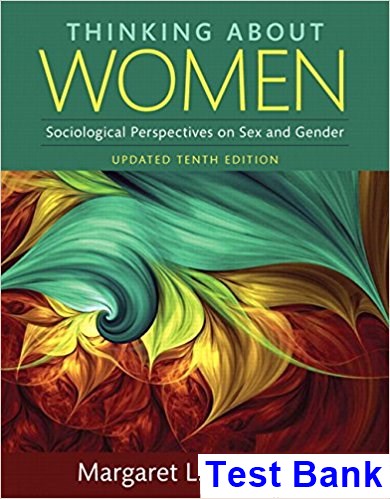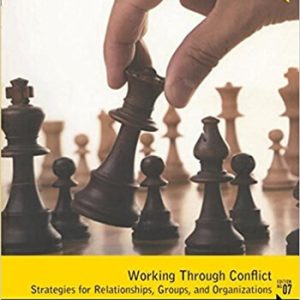This is completed downloadable of Thinking About Women 10th Edition Andersen Test Bank

Product Details:
- ISBN-10 : 013406173X
- ISBN-13 : 978-0134061733
- Author:
This edition features the same content as the traditional text in a convenient, three-hole-punched, loose-leaf version. Books a la Carte also offer a great value-this format costs significantly less than a new textbook
Appropriate for Sociology of Gender and Sociology of Women courses.
This text examines how gender operates in every aspect of society and how the male and female experience are constructs of our social institutions.
You can also purchase a loose-leaf print reference to complement Revel Thinking About Women .
Table of Content:
- Chapter 1 Studying Women Why Gender Matters
- Learning Objectives
- 1.1: A Focus on Women: Taking Women Seriously
- 1.1.1: Studying Women: Women’s Studies and Feminist Scholarship
- 1.1.2: Feminism: What’s in a Label?
- 1.2: Connecting the Personal and the Political Sociological Perspective
- 1.3: What About Men?
- 1.4: Gender Matters… and So Do Race, Class, and Sexuality
- 1.5: A Framework for Thinking about Women
- Summary: Studying Women
- Chapter 2 The Social Construction of Gender
- Learning Objectives
- 2.1: Biology, Culture, and Society
- 2.1.1: Sex and Gender: What’s the Difference?
- 2.1.2: Creating Sex: The Biological Process
- 2.1.3: Assigning Sex Identities
- 2.1.4: Biological Determinism
- 2.1.5: What Difference Does Difference Make: Nature? Nurture?
- 2.1.6: The Difference Culture Makes
- 2.1.7: The Institutional Basis of Gender
- 2.2: Socialization and Gender Identity An Ongoing Process
- 2.2.1: Sanctions and Expectations
- 2.2.2: Race and Gender Identity
- 2.2.3: Socialization across the Life Course
- Infancy
- Childhood Play and Games
- Schools, Sports, and Socialization
- Adult Socialization and Aging
- 2.3: Theoretical Perspectives on the Formation of Gender
- 2.3.1: Identification Theory
- 2.3.2: Social Learning Theory
- 2.3.3: Cognitive-Developmental Theory
- 2.3.4: Symbolic Interaction and “Doing Gender”
- 2.3.5: Comparing Theoretical Perspectives
- 2.4: Is Socialization Enough?
- Summary: The Social Construction of Gender
- Chapter 3 Gender, Culture, and the Media
- Learning Objectives
- 3.1: Gender and Language
- 3.2: Popular Culture and the Media
- 3.2.1: Analyzing the Media
- 3.2.2: The Body Culture
- 3.2.3: Portrayals of Aging
- 3.2.4: Presenting Women’s Sports
- 3.2.5: Gender, Children, and the Media
- 3.2.6: Diverse, but Controlling, Images
- 3.2.7: Violence, Sexualization, and the Media
- 3.2.8: Theorizing the Media’s Influence
- The Reflection Hypothesis
- Role-Learning Theory
- Organizational Theories of Gender Inequality
- Capitalism and the Media
- Social Construction Theory and Postmodernism
- 3.3: The Sociology of Knowledge
- 3.3.1: Karl Marx: Power, Profit, and the Production of Ideas
- 3.3.2: Karl Mannheim: Knowledge and Ideology
- Summary: Gender, Culture, and the Media
- Chapter 4 Sexuality and Intimate Relationships
- Learning Objectives
- 4.1: The Social Construction of Sexuality
- 4.2: The History of Sexuality in the United States
- 4.3: Contemporary Sexual Attitudes and Behavior
- 4.3.1: Women and Men: Still a Double Standard?
- 4.3.2: The “Hooking Up” Culture
- 4.3.3: Equal Rights for All? Changing Public Opinion about Lesbians and Gays
- 4.4: Sexual Development over the Life Cycle
- 4.4.1: Menstruation
- 4.4.2: Menopause
- 4.5: Race, Sexuality, and Power
- 4.5.1: Race and Sexual Politics
- 4.5.2: Sex Work and Sex Trafficking
- 4.6: Love and Intimate Relationships
- 4.6.1: Interracial Relationships
- 4.6.2: Friendship
- 4.7: Lesbian, Gay, Bisexual, and Transgender Experiences
- Summary: Sexuality and Intimate Relationships
- Chapter 5 Gender, Work, and the Economy
- Learning Objectives
- 5.1: Women’s Work: History Matters
- 5.1.1: The Family-Based Economy
- 5.1.2: The Family-Wage Economy
- 5.1.3: The Family-Consumer Economy
- 5.2: What Counts as Work? The Lingering Role of Ideology
- 5.2.1: The Cult of True Womanhood
- 5.2.2: The Emergence of Modern Housework
- 5.2.3: What Is Work?
- 5.3: Race, Class, and Gender Stratification
- 5.3.1: The Significance of Class
- 5.3.2: Race Matters
- 5.3.3: Economic Restructuring and the Economic Downturn
- 5.4: Gender in the Workplace
- 5.4.1: Who Is in the Work Force?
- 5.4.2: Who Works Where? Gender Segregation
- Women in the Professions
- Women as Clerical Workers
- Women in Blue-Collar Work
- Women and Service Work
- 5.4.3: Why the Pay Gap?
- Human Capital Theory
- Dual Labor Market Theory
- 5.4.4: Hitting the Glass Ceiling
- 5.4.5: Gender and Immigration
- 5.4.6: The Climate in the Workplace
- Being the “Only”: Tokens at Work
- Sexual Harassment
- Homophobia in the Workplace
- Disability: Enabling Workers
- 5.5: Poverty and the Declining Safety Net
- 5.5.1: Poverty: A Woman’s Issue
- 5.5.2: Welfare: Is It Working?
- 5.5.3: Retirement and Social Security
- 5.6: Who Cares? The Intersection of Family and Work
- 5.6.1: Housework: Changing with the Times
- 5.6.2: The Second Shift … and, Now, a Third: Care Work
- 5.7: Policies for Gender Equity
- Summary: Gender, Work, and the Economy
- Chapter 6 Gender and Families
- Learning Objectives
- 6.1: Historical Perspectives on Modern Families
- 6.1.1: Origins of the Western Family
- 6.1.2: Idealized Womanhood
- 6.1.3: Shaping Public and Private Spheres
- 6.2: Feminist Perspectives on Families
- 6.2.1: The Social Construction of Families
- 6.2.2: Diversity in Families: The Intersections of Class, Race, and Gender
- 6.2.3: Linking Social Structure and Human Action
- 6.2.4: The Family Ideal
- 6.3: A Portrait of Contemporary Families
- 6.3.1: Marriage
- 6.3.2: Divorce
- 6.3.3: Cohabitation
- 6.3.4: Gay and Lesbian Families
- 6.3.5: Motherhood
- 6.3.6: Fatherhood
- 6.3.7: Balancing Family and Work
- 6.4: Families in Trouble
- 6.4.1: Partner Violence
- 6.4.2: Marital Rape
- 6.4.3: Incest and Sexual Abuse
- 6.4.4: Teen Pregnancy
- 6.5: Families and Social Policy
- 6.5.1: Child Care
- 6.5.2: Family-Friendly Policies at Work
- Summary: Gender and Families
- Chapter 7 Women, Health, and Reproduction
- Learning Objectives
- 7.1: The Social Structure of Health
- 7.1.1: Gender, Work, and Health
- 7.1.2: Race, Class, and Health
- 7.2: Gender, Health, and Social Problems
- 7.2.1: Gender and the Body: Weight, Food, and Body Image
- 7.2.2: Substance Abuse: Alcohol, Drugs, and Smoking
- Alcohol
- Drugs
- Smoking
- 7.2.3: Women and AIDS
- 7.2.4: Disability
- 7.3: The Politics of Reproduction
- 7.3.1: Birth Control
- 7.3.2: Abortion
- 7.3.3: Racism and Reproduction
- 7.3.4: The Politics of Birth: Pregnancy and Childbirth
- 7.3.5: New Reproductive Technologies
- 7.4: Gender and the Health-Care System
- 7.4.1: Women as Health-Care Workers
- 7.4.2: Health Insurance
- 7.4.3: The Women’s Health Movement
- Summary: Women, Health, and Reproduction
- Chapter 8 Women and Religion
- Learning Objectives
- 8.1: Religion A Social Force in People’s Lives
- 8.1.1: The Influence of Religion
- 8.1.2: Religion as Social Control: The Case of Witches
- 8.2: Religion and the Rise of Feminism in the United States
- 8.3: Women, Gender, and Religious Faith
- 8.3.1: Images of Women in Religion
- 8.3.2: Religious Texts as Interpretive Documents
- 8.3.3: Gender and Religious Beliefs
- 8.4: Women’s Status in Religious Institutions
- 8.4.1: Religion and the Gender Division of Labor
- 8.4.2: Women as Clergy
- 8.5: Religion and Social Justice
- 8.5.1: Race, Religion, and Civil Rights
- 8.5.2: Religion and Antifeminism
- 8.5.3: Feminism and the Religious Right in the United States
- 8.5.4: The Abortion Debate: A Conflict of Worldviews
- 8.5.5: Faith, Feminism, and Spirituality
- Summary: Women and Religion
- Chapter 9 Gender, Crime, and Deviance
- Learning Objectives
- 9.1: Understanding Deviance and Crime
- 9.1.1: Early Studies of Crime and Deviance
- 9.1.2: Defining Deviance
- 9.1.3: Labeling and Social Deviance
- 9.1.4: Deviance, Power, and Social Conflict
- 9.1.5: Feminist Perspectives on Deviance
- 9.2: Women as Victims of Crime
- 9.2.1: Rape
- 9.2.2: Causes of Rape
- Gender Socialization as a Cause of Rape
- Rape and the Political-Economic Status of Women
- 9.3: Women as Criminals
- 9.3.1: Women’s Crime: How Much?
- 9.3.2: Causes of Women’s Crime
- 9.4: Women in the Criminal Justice System
- 9.4.1: Gender and the Courts
- 9.4.2: Women in Prison
- Summary: Gender, Crime, and Deviance
- Chapter 10 Gender, Education, and Science
- Learning Objectives
- 10.1: The History of Education: Patterns of Exclusion
- 10.2: Gender and Educational Success
- 10.2.1: Gender and Schooling
- 10.2.2: Academic Achievement: Is There a Gender Gap?
- 10.2.3: Gender and the Curriculum
- 10.2.4: Class and Race Inequality
- 10.3: The Gender Gap in Higher Education
- 10.3.1: Sexual Harassment
- 10.3.2: The Special Insights of “Outsiders”
- 10.4: Gender, Science, and Society
- 10.4.1: The Status of Women in Science
- 10.4.2: Science, Feminism, and the Social Construction of Knowledge
- 10.4.3: Ways of Knowing
- 10.4.4: Feminist Standpoint Theory
- Summary: Gender, Education, and Science
- Chapter 11 Women, Power, and Politics
- Learning Objectives
- 11.1: Defining Power
- 11.2: Women and the State
- 11.3: Women and the Law
- 11.4: Women in Government
- 11.4.1: The Gender Gap
- 11.4.2: Do Women Make a Difference?
- 11.5: Women and the Military
- 11.5.1: Lesbians and Gays in the Military
- 11.5.2: Feminism and Militarism
- 11.6: Rethinking the Political
- 11.7: The Women’s Movement
- 11.7.1: American Feminism in the Nineteenth Century
- 11.7.2: The Emergence of the Contemporary Women’s Movement
- 11.7.3: Feminism and Civil Rights
- 11.7.4: The Second Wave of Feminism
- 11.7.5: Feminism for the Twenty-First Century: A Third Wave
- Summary: Women, Power, and Politics
- Chapter 12 Women and Social Reform Liberal Feminism
- Learning Objectives
- 12.1: Frameworks of Feminist Theory
- 12.2: The Liberal basis of Modern Feminism
- 12.3: Liberalism as a Mode of Social Thought
- 12.3.1: The Origins of Liberal Thought: An Age of Enlightenment?
- 12.3.2: The Continuing Influence of Liberal Thought
- 12.4: Early Liberal Feminists
- 12.4.1: Mary Wollstonecraft
- 12.4.2: Harriet Martineau
- 12.4.3: John Stuart Mill and Harriet Taylor Mill
- The Logic of Inquiry
- The Social Construction of Gender
- Work and the Family
- 12.5: The Critique of Liberal Feminism
- Summary: Women and Social Reform
- Chapter 13 Contemporary Frameworks in Feminist Theory
- Learning Objectives
- 13.1: Diverse Frameworks of Feminist Thought
- 13.2: Socialist Feminism The Importance of Class and Capitalism
- 13.2.1: Karl Marx and Historical Materialism
- 13.2.2 Class and Capitalism
- 13.2.3: Ideology and Consciousness
- 13.2.4: The Woman Question
- 13.2.5: The Feminist Critique of Marx
- 13.2.6: Family and Economy in Capitalist Society: Juliet Mitchell
- 13.2.7: The Question of Separate Spheres
- 13.3: Radical Feminism The Power of Patriarchy
- 13.3.1: The Sex/Gender System
- 13.3.2: Sexuality and the State
- 13.3.3: Intersections of Capitalism and Patriarchy
- 13.3.4: Comparing Liberal, Socialist, and Radical Feminism
- 13.4: Multiracial Feminism An Intersectional Analysis
- 13.5: Postmodernist Feminism
- 13.6: Queer Theory and Sexualities
- 13.7: Continuing Questions for Feminist Theory
- Summary: Contemporary Framework in Feminist Theory
- Bibliography
- Glossary
- Author Index
- A
- B
- C
- D
- E
- F
- G
- H
- I
- J
- K
- L
- M
- N
- O
- P
- Q
- R
- S
- T
- U
- V
- W
- X
- Y
- Z
- Subject Index
- A
- B
- C
- D
- E
- F
- G
- H
- I
- J
- K
- L
- M
- N
- O
- P
- Q
- R
- S
- T
- U
- V
- W
- Y





